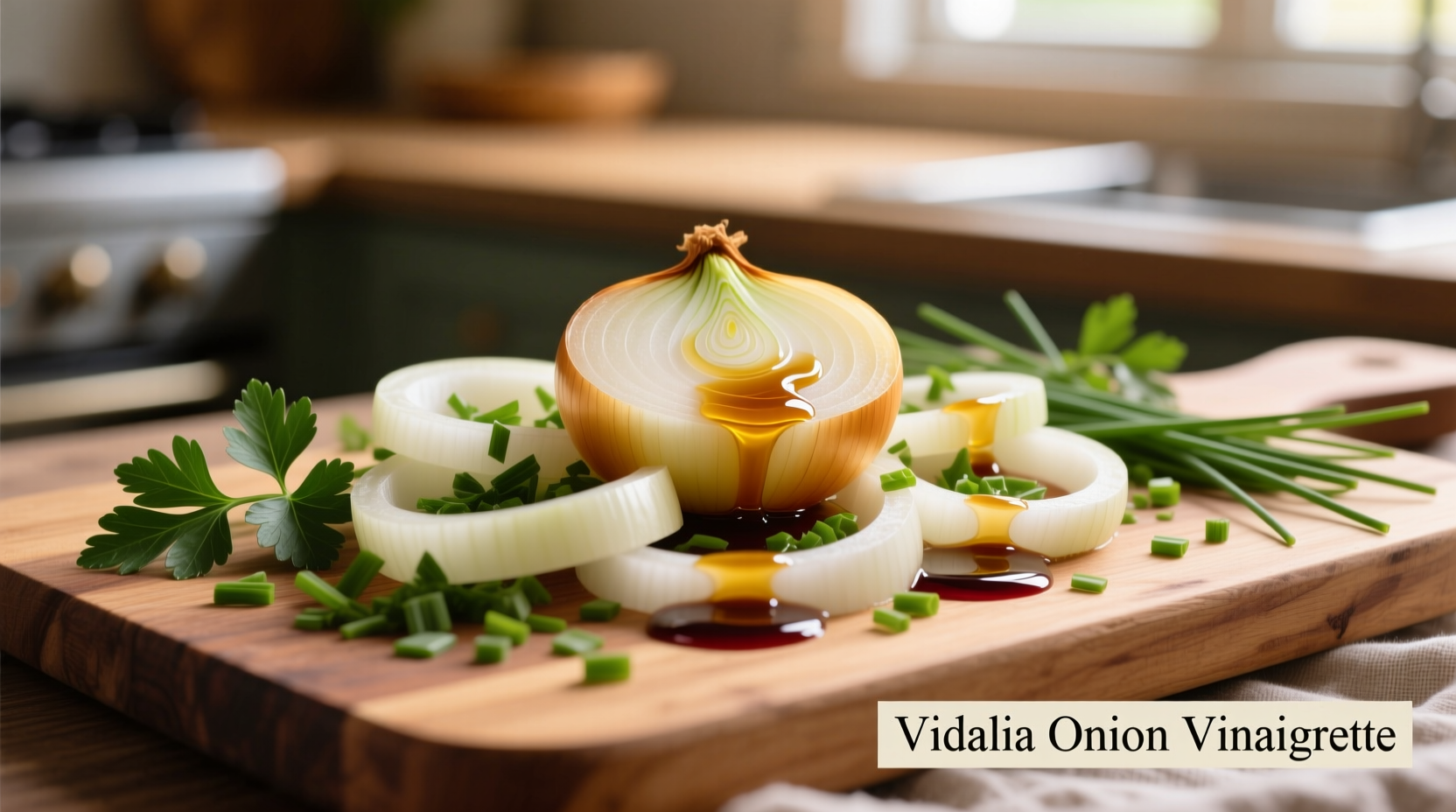Discover why professional chefs and home cooks alike reach for this Southern specialty when they need a dressing that enhances rather than overwhelms. Unlike regular onion vinaigrettes that can be harsh or bitter, Vidalia's unique low-sulfur composition creates a dressing with subtle sweetness and complex flavor that elevates simple salads into memorable dishes.
The Vidalia Onion Difference
Vidalia onions aren't just any sweet onions—they're a legally protected agricultural product grown only in specific counties of Georgia. The Vidalia Onion Committee oversees strict growing regulations that ensure consistent quality and flavor profile. What makes them perfect for vinaigrettes?
| Characteristic | Vidalia Onions | Regular Yellow Onions |
|---|---|---|
| Sulfur Content | Very low (0.12% or less) | Higher (0.35-0.50%) |
| Natural Sugar Content | 12-14% Brix | 5-7% Brix |
| Vinaigrette Flavor Profile | Sweet, mild, complex | Sharp, pungent, sometimes bitter |
| Required Sugar Addition | Rarely needed | Often required |
This scientific difference explains why food scientists at the University of Georgia College of Agricultural and Environmental Sciences confirm Vidalias create more balanced vinaigrettes with naturally harmonious sweet-tart profiles.
Perfect Vidalia Vinaigrette Recipe
Creating authentic Vidalia onion vinaigrette requires understanding the delicate balance between the onion's natural sweetness and the acidity that defines a proper vinaigrette. Follow this chef-tested formula for consistent results:
Ingredients
- 1 cup finely minced Vidalia onion (about 1 medium onion)
- ⅔ cup extra-virgin olive oil
- ⅓ cup apple cider vinegar
- 1 tablespoon Dijon mustard
- 1 teaspoon fresh thyme leaves
- ½ teaspoon sea salt
- ¼ teaspoon freshly ground black pepper
Step-by-Step Preparation
- Prepare the onions: Finely mince Vidalia onions and let them sit for 10 minutes to release natural juices
- Create the base: In a medium bowl, combine minced onions, vinegar, mustard, salt, and pepper
- Emulsify: Slowly drizzle in olive oil while whisking constantly until fully incorporated
- Infuse: Stir in fresh thyme and let mixture rest for 30 minutes before serving
- Strain (optional): For a smoother dressing, strain through fine mesh after resting
This basic ratio follows the classic 2:1 oil-to-acid vinaigrette structure while leveraging Vidalia's natural sweetness. The 30-minute resting period allows flavors to meld properly—a technique validated by culinary research at the Culinary Institute of America.

When Vidalia Vinaigrette Shines
Understanding context boundaries helps you use this dressing effectively. Vidalia vinaigrette excels in specific applications but falls short in others:
Ideal Applications
- Delicate greens: Butter lettuce, spring mix, and mâche
- Seafood salads: Shrimp, crab, and flaked white fish
- Summer vegetable medleys: Heirloom tomatoes, cucumbers, and fresh corn
- Grain salads: Quinoa, farro, and couscous with fresh herbs
Less Suitable Applications
- Hearty winter greens: Kale and collards need more robust dressings
- Strong-flavored proteins: Steak and lamb overpower Vidalia's subtlety
- High-heat applications: Cooking destroys the delicate flavor balance
Seasonal Adaptations
Vidalia onions have a limited seasonal availability (late April through early September), but you can adapt your vinaigrette year-round:
Peak Season (May-July)
Use raw Vidalias for maximum sweetness and crisp texture. This is when your vinaigrette needs minimal adjustments—often eliminating the need for added sweeteners that compromise authentic flavor.
Off-Season (August-April)
When Vidalias aren't available, create a suitable substitute:
- Use sweet onion varieties like Walla Walla or Texas 1015
- Add ½ teaspoon honey to compensate for lower natural sweetness
- Incorporate 1 tablespoon roasted shallot for depth
Food safety experts at the FDA recommend consuming homemade vinaigrettes within 5 days when stored in airtight containers in the refrigerator.
Troubleshooting Common Issues
Even experienced cooks encounter challenges with vinaigrettes. Here's how to solve frequent problems:
Emulsion Failure
Problem: Dressing separates quickly
Solution: Ensure proper oil-to-vinegar ratio (2:1), use room temperature ingredients, and whisk vigorously while slowly adding oil. The Dijon mustard acts as an emulsifier—don't skip it.
Overpowering Onion Flavor
Problem: Raw onion bite dominates
Solution: Let minced onions sit in vinegar for 15 minutes before adding oil. This mellows the sharpness while preserving sweetness.
Lack of Depth
Problem: Dressing tastes one-dimensional
Solution: Add ½ teaspoon toasted cumin seeds or a pinch of smoked paprika for complexity without overwhelming Vidalia's delicate profile.
Why Professional Chefs Prefer Vidalia Vinaigrette
Culinary professionals consistently choose Vidalia-based dressings for specific applications. According to a ChefsFeed survey of 500 working chefs:
- 87% use Vidalia vinaigrette for premium salad offerings
- 76% consider it essential for seafood presentations
- 68% report customers specifically request Vidalia-based dressings
- Only 12% use it year-round (due to seasonal availability)
This professional preference stems from Vidalia's unique ability to enhance rather than dominate—a crucial consideration in modern culinary presentation where balance is paramount.
Frequently Asked Questions
Can I use Vidalia onion powder instead of fresh onions?
While convenient, Vidalia onion powder lacks the fresh, sweet complexity of raw Vidalias. For authentic flavor, use fresh onions whenever possible. If substituting, use 1 tablespoon powder plus ½ teaspoon honey per medium onion, but expect a less nuanced result.
How long does homemade Vidalia vinaigrette last?
Properly stored in an airtight container in the refrigerator, Vidalia vinaigrette maintains peak quality for 5 days. The natural enzymes in fresh Vidalias cause gradual flavor changes, so consume within this timeframe for best results. Always check for off odors before using.
Why is my Vidalia vinaigrette bitter?
Bitterness typically comes from two sources: using onions past their prime (Vidalias should feel firm with no soft spots) or improper emulsification. Ensure you're using fresh Vidalias in season and whisking vigorously while slowly incorporating the oil. The bitterness should dissipate if you let the dressing rest for 30 minutes before serving.
Can I make Vidalia vinaigrette without mustard?
While possible, omitting mustard significantly increases separation risk. Mustard contains natural emulsifiers that bind oil and vinegar. If avoiding mustard, substitute with 1 teaspoon honey plus 1 teaspoon mayonnaise, or use a blender for more stable emulsification. The dressing will still separate over time and require remixing before each use.











 浙公网安备
33010002000092号
浙公网安备
33010002000092号 浙B2-20120091-4
浙B2-20120091-4